Birdingpals Trip Report
Trip Report Argentina – April 24th to May 12th, 2003
by Birdingpal Knud Rasmussen
My journey to Argentina to meet the local Birdingpals
My trip to Argentina was not solely for birding but also to experience as much of the
daily life in a different country as possible. Argentina did not disappoint us and it
met all our expectations. A country well worth the visit, with great nature, friendly
people and still many unspoiled places to see. Could also be a great place for "snowbirds"
with a pleasant climate, economical lodging and little crime. It was also to try first
hand, the advantage of using local contacts through Birdingpal, to not only get better
birdwatching but also to meet new friends and I can say I was not disappointed.
In the beginning of 2003 my son and I started planning a trip to Argentina. Why Argentina?
When you look at a map, you will soon realize that Argentina is all of North America
combined. From the Arctic north of Canada down to the Subtropics of Mexico, one can
travel through many types of landscapes without the vast distances of North America.
Our time frame for such a trip would be late April to May, which would be late fall
there. You can still count on reasonable weather in the Northern part of Argentina and
then, after a long winter in Ontario, Canada it will be like a taste of our spring.
Since we wanted to see as much of the country as possible, we decided to rent a car and
do all the driving our selves. The main highways are all in excellent shape even if most
of them are only a single lane in each direction. Traffic is generally modest as soon as
you are away from major cities. Even if they have posted speed limits, we never met an
Argentinean driver respecting them, and we saw very few patrol cars during our 5600 km
trip. One thing we noticed was that all trucks kept their speed limit of 80 km and that
was probably the reason we only saw two accidents during our entire trip, both involving
a single truck. The secondary roads ranged from excellent to really poor and when
Argentineans post a Bump or Dip sign, you better slow down; they are not kidding! In
some places we also saw quite a bit of live stock on the high ways(mostly untethered)
ranging from horses to cattle, pigs and chickens but they seemed to know not to cross
the road. Any reasonable experienced driver can drive in Argentina but one must always
be on the alert for what happens ahead. The only thing that frightened us was the
condition of some of the cars and trucks, especially at night. The cities are somewhat
different, and my first drive in Buenos Aires at night with a native directing me was
quite an experience. They all drive as fast as possible and no one pays any attention
to lane markings. My friend instructed me to follow the traffic(at a 100 km an hour),
and pay attention only to traffic on my left side because the ones on the right side
would keep an eye on me(unless it's a bus or truck). Don't worry about Mopeds, cyclists,
horse wagons or pull carts, just don't hit them. Most intersections have signal lights,
so they are easy. The rest I still think is a game of chicken but I am sure they have
rules. If you are not a nervous driver it's easy to drive in the cities after you get
over the first shock. One other observation about driving in Argentina: a lot of cars
and two wheeled vehicles have no mufflers(and I think some even added an amplifier on
top) so the noise is tremendous and I also think it was kind of a macho thing for some
of the drivers. If you want a good nights sleep make sure to get a hotel room away from
any street and even that is no guarantee. Remember Argentineans start work early(5 am),
then take a siesta around 1 p.m., they start back around 5 p.m. And the noise continues
into the night(1 am). The natives did not seem to mind it but I found it difficult to get
used to, even if I have been living in a large and noisy Metropolitan area for many years.
Argentina beats any thing I have ever experienced.
Argentina is a country with a well developed infrastructure much like North America and
Europe, and we experienced no problems with phones, Internet, electronic banking,
electric power(remember it's 200/1/50 power, I forgot and fried a battery charger),
water etc. It's definitely a plus if you speak Spanish since few people speak English
there, but that does not mean you can't handle the daily logistics if a little flexibility
is used. Bigger hotels and stores usually have at least one English speaking person but
do not count on more than that. The younger people are much better and the girls seemed
less shy trying their English than the boys.
April 24
The start of the trip.
All went well going through US customs and immigration in Toronto with my scope,
binoculars etc. We boarded a United Airlines flight to Chicago but almost didn't get
further than the tarmac since the truck pulling us out from the gate broke the
connecting rod and we waited more then an hour before we got the green light to
continue. The rest of the flight to Miami and Buenos Aires went off with out any
problems. Flying business class made a big difference specially from Miami to
Buenos Aires, since we were able to sleep properly on the reclining seats.
April 25
Buenos Aires.
As it was light when we approached BA, the landscape looked the same from the air as
the one we had left the day before in Ontario, except it is greener. We landed at 9.10
am local time, slightly ahead of schedule, and cleared emigration and customs with out
any delays. I saw my first Argentinean lifer; a Roadside Hawk, as the plane landed.
As we entered the terminal hall we were met by Sergio Corbet, a local birdingpal, who
provided much valuable help not only during our trip but also in the planning of it,
and of course, he also took me birding. Sergio got us a "remise" van to take us to the
hotel(30 pesos/$15 Canadian including tips) where we checked in, had a quick shower and
went to check out the local cerveza.
After that we went sightseeing for our first impressions of Buenos Aires, a fast moving
metropolitan of 7 million people. Compared to the many cultures of Toronto, it seemed much more
uni-cultural. Before we started the trip we had read a lot about the economic situation
in Argentina including the pot banging demonstrations, and as soon as we entered the
walking mall(like Stroeget in Copenhagen) we encountered our first and only demonstration
in an intersection with banks on each corner. The bank buildings where all covered with
steel plates and small guarded steel doors and watched by police. There was a lot of
noise from people banking with pots, hammers etc. Suddenly an armoured car went through
the inter section and a young, very attractive women attacked it with a hammer and I
thought "Now the police will step in" but they just ignored it and I realized that it
was a money transport truck and not a police wagon. In all the time we spent in Argentina
we saw almost no violence and neither TV nor the newspapers reported much crime compared
to the bombardment we receive daily from the North American media.
I had lunch with Sergio in the headquarters building for the old English Pacific Railway
Company nationalized by the state some time ago, and now turned into a modern shopping
centre.
We then went to a local travel agent to finalize the itinerary for the trip.
This later proved to be of great value, because we had to make several changes later on
due to severe flooding in Santa Fe during our trip. Ms. Mercedes de Aldecoa from the
travel agent was also able to get some very attractive prices for the hotels we stayed
in during the trip. They ranged from $25 to 50 Canadian per night for a double room in
good hotels and including breakfast. Then off to a local car rental where we rented a
mid size Korean car for 17 days, including 4600 km free for $1100 Canadian with insurance,
tax and two drivers.
Now for my first drive in Buenos Aires to a parking lot Sergio recommended near the hotel,
and it only cost 20 pesos for three days. Then it's off for our first real Argentinean
dinner. Beef of course, grilled and medium rare. $30 Canadian for three people including
appetizers, wine and coffee. It's difficult to get used to the prices here. It's pouring
rain(the first and only serious rain we had during the entire trip) on the way back to
the hotel Savoy(a nice place but somewhat faded) by 10.30 pm to watch BBC news on TV
before going to bed.
"Getting ready for election"
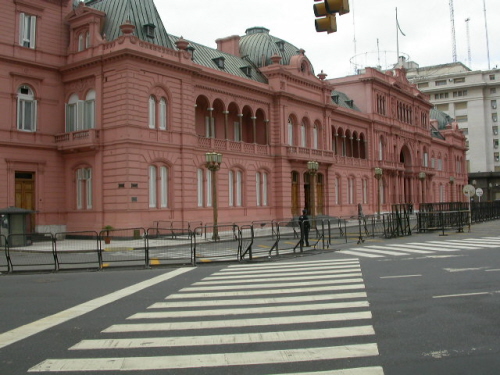
April 26
First birding in Argentina
Up at 6.30 am after little sleep because of the street noise and down for my first
Argentinean breakfast. Good strong coffee as I like it, freshly squeezed orange juice
and croissants. Reading my "Birds of Southern South America and Antarctica", 937 species
in Argentina so there is a lot to learn.
Sergio picks me up at 9 am and we get the car. Its cloudy with some rain but we decide
to go anyway. First stop is Otamendi NR Nature Reserve north of Buenos Aires. When we get
there it has stopped raining and it's pleasantly warm. This is wetland, and we bird
mostly from the car, getting out when we find something interesting like a small tree
with two Green-barred Woodpeckers, a Field flicker, five Monk Parakeets and three
Scarlet-headed Blackbirds. Also Giant Rail walking on the road and the large Ringed
Kingfisher as well as Green Kingfisher flying over us calling just to name a few.
Then it's off to Ranch close to Brazo Largo in the province of Entre Rios for more birding
and I liked this better because we walked on the cattle trail all afternoon until almost
dark. Sergio tells me I am the first birder who wants to walk and bird , all the other
birders he has helped want to drive, stop, see a bird and then off to the next one. It's
a shame because one miss out on seeing the plants, animal tracks, Coypu and Capibara
droppings etc. I saw a White-headed Woodpecker, White Monjita, many Limpkins, Southern
Screamers and Southern Lapwings, to name a few: Total 69 lifers. Not bad for this time of
year. I also met my first Gaucho on horseback complete with a large knife in his belt.
Then it was off for the drive of my life time the Argentinean way. Back to the hotel and
Sergio and I really needed a cerveza when we arrived. Red meat and wine for dinner again.
Wonder how long it will take before I start longing for Karen's pasta at home.
April 27
Tourist in Buenos Aires
Woke again at 4 am to the sound of unmufflered traffic but only one more night and we
are on the way to Mendoza. Since Alfred spent yesterday with his Argentinean friend Laura,
he acted as a tour guide.
Lots of police around setting up barricades around government buildings in anticipation
of demonstrations after the national election for president. It's quite exiting for us to
be in another country when they have elections, and to see democracy at work. As things
went they ended up with a run off election between Mr. Kirchner and Mr. Menem, and we now
know that since Menem quit before the run off, Kirchner is the new president of Argentina.
As far as the police were concerned, they had a quite day with nice weather and the next
day all signs of the election were gone, except for a few flyers on the street.
We walked all day enjoying the many beautiful buildings in Buenos Aires, the parks and
the old harbour. Because of the election we could not have cerveza with our lunch but we
survived. Found a huge open market with handcraft, music and all kinds of entertainment
plus we visited the cemetery where Evita Peron's mausoleum and those of many other great
families are located. Quite different from what we have seen till now and it indicates
the history of Argentina as cemeteries all over the world usually do.
Got back to the Savoy around 6 pm and rested to 8.30 when we went out again in search of
an Internet cafe. That was not difficult, since there are many of them, but some are
better than others. Better equipment and High Speed access to name a few and only 1
Canadian dollar per hour to rent a PC.
Since we had been told that the best pizza in the world is in Argentina, we decided to
try it out. Not bad but they sure could learn a few things from the Italians living in
Toronto; but then again it was only $6 Canadian including a bottle of vine(The restaurants
could start serving alcohol again after 9 pm). Back to the hotel for a good night sleep
I hope.
"Evita Peron's mausoleum"

April 28
On the way to Mercedes in the province of San Louis
The adventure starts and we are on our own and have an 800 km trip ahead of us. We are up
early for breakfast and I settle my bill with the hotel. $3 for phone use and $35 for
the dinner Sergio and I had on Saturday after birding and my christening in how to drive
in BA. Appetizers, Cerveza, great steaks, an excellent bottle of red wine, coffee and
cognacs. This is definitely a cheap country to go out and dine in. Wish it was the same
in Toronto; and by the way all prices stated from now on are Canadian.
A few minor delays in getting out of rush hour BA and finding Ruta #7. The roads are
excellent and service stations are clean and friendly. We enjoy the changing landscape
from the suburbs of a large city to that of farming, cattle grazing and wet lands. All
look quite prosperous and we are making good time. Argentina has many toll roads and that
is probably why the roads are in such good condition. A few police checkpoints, which are
common all over the country. We are looking forward to arriving in Mercedes in late
afternoon but this is not how things will go. When we stop at the toll booth just before
Junin in the province of Buenos Aires the operator will not take our money and we can't
understand what he is trying to say. Luckily a man stopped and came over to find out what
is going on and he spoke very good English. The problem was the road was closed because of
flooding and he showed us how to make a bypass. It's only 250 km extra driving so we are off
to Rojas, then follow Ruta #8 to Vernado Tuerto and down #33 to Rufino and back on Ruta #7.
When we crossed into the province of Santa Fe we ran into a police checkpoint in the middle
of no where, and I am sure it's a long time since they had a couple of Canadians going through.
The two officers of course spoke no English but the first one was very helpful showing us on the
map where to go and writing down the distances on a slip of paper he tore out of his note book.
He then started to talk about pesos(I did see his partner getting something from other cars being
stopped) but since I do not speak Spanish I asked and showed him to write the amount down on the
slip of paper he gave me. He called his partner over and he also gave me a long story but did not
want to write down how many pesos. Eventually they waved us through so this was probably the only
advantage of not speaking Spanish and was the only time anyone tried to shake us down during the whole trip.
We finally arrive in Mercedes and it's before dark so we have no problem finding the
hotel Centro. It's like any old-fashioned European hotel. Small room, small bath room and
small beds but not bad for $28 including breakfast and all facilities are working. No one
speaks English but I managed to get the name of a good restaurant from a old man on the
front desk.. This is quite a lively city but I am sure the people from Buenos Aires would
look down their noses at it. It just so happened that we had our best red meat dinner
here during the entire trip, and it was a lot cheaper than the fancy ones we went to
later. Again, many Internet cafes, so no problems checking our emails.
"Art school in Mercedes"
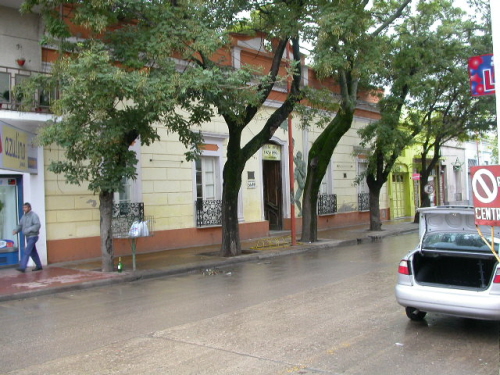
April 29
On to Mendoza for a few days rest.
I got up early and went for a walk before breakfast. The homes in Mercedes typically have
little if any front yard, are all fenced in and have shutters in front of the windows.
Early in the morning you can do a little spying since the windows often are open and you
can see into the homes. They look like any North American or European home with refrigerator,
kitchen gadgets, TV and seem quite conformable.
Then we are off on Ruta #7 again. Excellent roads with quite a bit of it being divided
motorway. The wet land is beginning to disappear and it is still cattle country but drier
and more hilly. We now cross the border between San Louis and Mendoza and at the police
checkpoint, they want to know if we are bringing any fruit or meat with us but there is
no shake down and they are very friendly. Now you can buy wine in all gas stations and
stands along the high way and huge grape fields begin to appear. We notice much less wild
life in these two provinces than Cordorba, most likely because it is much drier land here.
We arrive in Mendoza 1.30 pm and it looks like a very nice prosperous city with the Andes
in the back ground. It reminds me of Calgary, Alberta with mostly new buildings in the
downtown area. We find hotel Aconcagua without any problems(It makes a big difference if
you arrive in the afternoon when it's still daytime and the traffic is light). It's a
nice modern place with lots of very good local art exhibited in the garden and lobby.
The room is modern and comfortable and not too noisy. It's still siesta and few stores
and restaurants are open but we go for a walk to familiarize ourselves with the city and
then, back to the hotel for a belated siesta. We walk down town at 9 pm and Mendoza is
alive with people. Stores, restaurants and businesses are open and lots of people of any
age are on the street. Decided not to eat red meat today, so we found a restaurant
serving chicken but both food and service turned out to be one of the least memorable in
my lifetime and I think unusual for Argentina.
"Ruin from the 1861 earthquake"
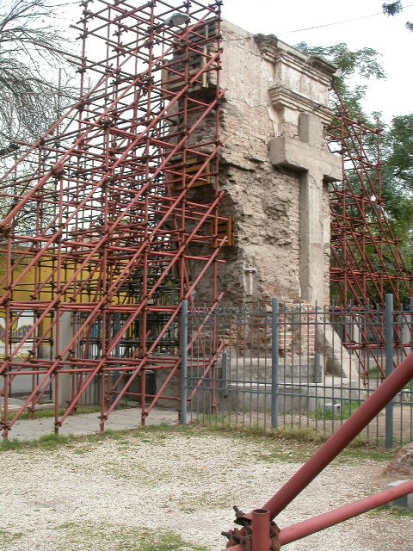
April 30
Being a tourist in Mendoza
We started out by meeting Eduardo Sosa, a local Birdingpal, early in the morning. Even
thought he was not able to go birding with me due to his work, he gave me very good local
information which I used the following day. We were also now aware of severe flooding
around the city of Santa Fe where we had planned to cross the Parana river to the
city of Parana in Entro Rios. Eduardo was very helpful in investigating if it would be
possible but we soon realized that roads where closed not only to Santa Fe but also the
route we had planned using to drive to Cordoba. We contacted Sergio in Buenos Aires who
called Ms. Mercedes at Fortrip Travel and she cancelled our hotel in Parana and booked a
new one in Corrientes, the only place where we could cross the river north of Santa Fe.
This added about 600 km to the trip we had originally planned. But this was very bad
flooding with 28 people drowned, many more missing and a million head of cattle who just
wondered off.
We spent the rest of the day walking around in Mendoza, visiting the ruins and museum
from the earth quake which destroyed the city and that is probably why the buildings were
much newer than what we had seen so far. Had lunch in a small local restaurant. A bottle
of cerveza, wine and pizza all for $3 for two.
After our late siesta we went down town again to check and send emails but decided to go
back to our hotel for dinner around 10 pm. Barbecued ribs and an excellent bottle of
Argentinean wine. Somewhat more expensive than lunch but still under $30 and I can highly
recommend this restaurant.
"The Chef from Hotel Aconcagua"

May 1
Today is a holiday in Argentina and everything is closed so I go birding for the Condors.
Got up early and had breakfast at the hotel and went down to get the car, just to find
out the battery was flat. I paid the garage attendant $10 to give me a boost and off I
went to look for Condors 40 km west of Tunuyan city and up in the Andes. When I arrived
in Tunuyan, the car kept stalling when I stopped and it made me a bit nervous. What if it
broke down in the middle of no where, me not speaking Spanish and trying to find a
mechanic or some help. Anyway, I have come this far, so I will take the chance to see the
Condors, and deal with the car after. When I arrived at the park I went over to a native
Indian family having a picnic and showed them the picture in my bird book. The husband
recognized the Condor right away and pointed up to the mountains so I started to walk up
the slope when I heard shouting behind me and the man pointing up in the sky. Sure enough
there was my first Condor gliding over. The man then came over with his young daughter and
I lent them my binoculars and showed them all the birds they could expect to see around their home.
Who knows, I may have started the young girl on becoming a birder. She was definitely very interested
in the birds and it was most likely the first time in her life she had seen such a book.
Did a little birding along a small creek hoping to find a Dipper but no such luck. Still
added five new lifers to my list. On the way back I stopped to have a look at what looked
like a road side shrine and got very lucky. A small scrub next to it was alive with small birds and
the first new one I saw was a Red-tailed Comet and then a very small owl made a pit stop for a minute
and I saw my first Ferruginous Pygmy Owl. 96 lifers so far.
Returned to the hotel and no Alfred; he came waltzing in around 8.30 and told me he
completely forgot the time. Since every thing was pretty well closed, he had gone to the
local McDonald's for lunch and met an American women; and that was of course much more
interesting than the old man! Went for our first pasta dinner and it was not bad but I
guess the Italians in Toronto have shown us a long time ago that there is pasta and pasta,
so we are pretty fussy.
"Condor country in the Andes"
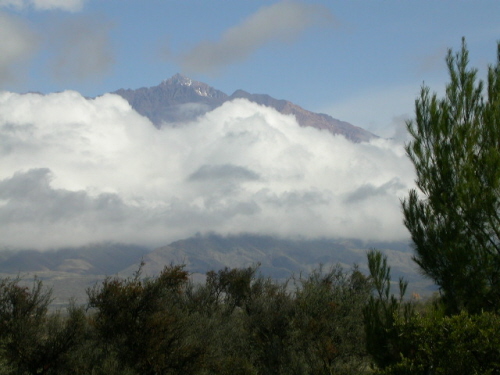
May 2
On the way to Cordoba
The day starts badly: we sleep in, have a late breakfast and meet with Eduardo and still,
no good news about Santa Fe. We finally get going and the car won't start. The same as
yesterday and since I am sure the lights where turned off this time I am beginning to
wonder if the garage attendant has a little side business going. We get a boost and we
are off. A bit of trouble to get out of town since the signs are often confusing in
Argentina, and the traffic is heavy. I am driving and Alfred navigating and suddenly he
realized that we took a wrong turn so we go back, and add an extra 90 km to our trip.
The landscape now turns into desert, no people live here and there are very few cars. We
again make a wrong turn at Parque Nac Sierra de las Quljadas, where I had planned to bird
for and hour or two but we can forget this now. I did some birding when we passed a dead
horse at the road side covered with Black Vultures. A lifer for me. The landscape now
turns into wet land and we stop to watch several flocks of Chilean Flamingos among the
many waterfowl we pass. On the Hydro lines running parallel to the road, we notice many
huge Monk Parakeet nests and sometime up to three on a pole but I guess they do not
interfere with the power lines. Getting very low on fuel but still no gas stations in
sight. At 2.30 pm we finally find one and fill up and have a sandwich and off we go again.
Alfred takes over the driving and I navigate. The landscape now turns into mountains
after Va Dolores when we enter the province of Cordoba and on the map they look like a
piece of cake. Beautiful landscape, but it is getting late and taking much longer than we
anticipated. Finally we are on the other side and 57 km from Cordoba and we enter the
city just as it gets dark. The traffic is crazy and the street names very confusing or
even non existent. I take over the driving since I am having trouble reading the map and
we finally get within a block of the hotel but are driving around in a circle and not
able to get on to the street because of walking and one way streets. It's now 9.30 pm
and we finally park the car close to the hotel and Alfred walks to it, just to find out
it's OK to drive on some of the walking streets and we are only a few minutes away.
Should have known better, rules are only a guide but very frustrating and we are
definitely stressed. Alfred goes for a walk to relax and I definitely need red meat and
wine to calm me down, so I have dinner at the hotel and then go to bed. I am finished
and need sleep, did not even hear Alfred come into the room.
"Flamingoes on the way to Cordoba"
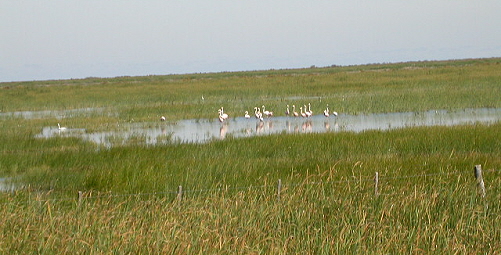
May 03
Relaxing in Cordoba a very fine city
When I get up, Alfred is still sleeping and I go down to check on the car. It starts, but
it is making me nervous and we still have a long way to drive. As I walk out of the
garage I noticed the car rental has an office next door and after breakfast I go in and
ask for the manager. The agency is run by a mother and daughter who both speak English
so there is no problem explaining that I would like to have a mechanic check the car
before we leave Cordoba. This is not possible until evening because no one works on
Saturdays, but the lady promises to look after it and call me at my room. Around 8 pm
I get a call from her and I go down to the office where she informed me that the car has
been replaced with another one just the same, but in better condition. Guess they did not believe the old one would have made it back to Buenos Aires. Anyway the two ladies were very helpful, and without them, we could have been stranded in the middle of no where and I do not think that would have been too funny.
I feel great to day because it was the first time I had a really good night's sleep.
The room faces out to a kind of back yard so the noise from macho guys with their
mufflerless cars is almost gone.
My local Birdingpal called the night before and I asked him to give me a call in the
morning but he never called or left a message. Guess you can't win them all.
We went for a walk to familiarize ourselves with the city and stop at the Argentinean
Auto Club for better maps and to check on the conditions in Santa Fe. We are told all
roads are closed until further notice. We are also told the roads north east of Cordoba
are flooded and closed so we are forced to drive north on Ruta #9, making the trip to
Corrientes even longer. Showing my CAA card(Canadian Automobile Association) gives me a
discount on the maps and I am now part of their database. I think the entire population
of Cordoba is on the street Saturday morning shopping, listening to music, speakers, and
panhandlers offering their goods. They also have statues of knights, circus artists etc.
in the middle of the walking streets, which certainly comes alive, when someone throw
money in a can. For a peso that was the first time during the trip I had a guy blowing
kisses to me.
Cordoba is an interesting place but for the first time I do notice a fair number of
homeless people and kids begging on the street and we are told that there is no work in
the country so they move in to town to try to survive. We spend the early afternoon
sight-seeing and looking at the many old buildings here in this former capital and
university city of Argentina. Now all the people are gone and I buy a bottle of wine to
take back to the hotel to enjoy on the deck in the court yard as I read my book about
Canadian history. We are now quit used to eating dinner at 9-10 o'clock in the evening
and to night we are going to a restaurant where through glass windows we can see the
chef grilling meat over wooden fire. I have meat grilled a la llama and, of course, some good red
wine. Excellent and less than $10.
"Cordoba Saturday morning"
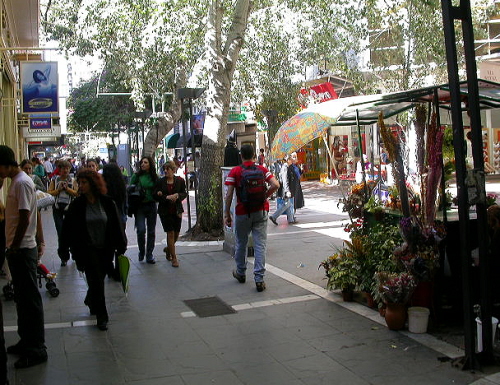
May 04
Sunday drive in the country side
We decided to spend the day driving around visiting the tourist towns around Embalse
San Roque and try to do a little birding. This is a very pleasant area where many artist
have their studios and people from Cordoba have their summer houses here. I think it
would be a great place to escape the Canadian winter for a couple of months and quite
inexpensive. Small quiet villages, but still an easy drive to Cordoba if you get tired
and want some action and noise. They even had a sail boat race going on the reservoir
when we passed by. Since we did not get in touch with the local Birdingpal, we used the
book "Where to go birding in South America" but it did not really help much in this area
so I only saw a few birds I had already seen. When I think about the help I got from
other pals on this trip, I can really appreciate the advantage of having a local birder
to help me out. Got back to town early and had an early dinner to get ready for the trip
tomorrow.
"Yacht club in Va Carlos Paz"
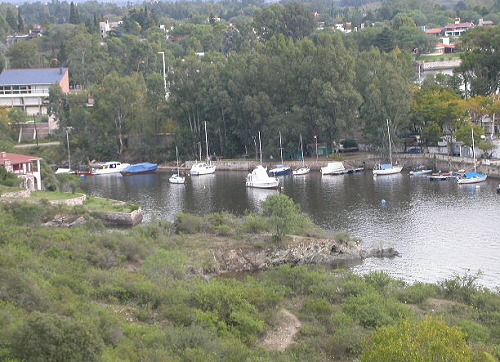
May 05
On the way to Corrientes
This is the longest trip so far approximately 1000 km, if we do not make any mistakes.
We are up early and leave the hotel at 7 am. Traffic is light and we get out of Cordoba
without any problems and hit Ruta #9. Again we missed the road we had planned to take
after we passed Va Ojo de Agua in the province of Santiago del Estero. It may have been
a blessing in disguise since it was a secondary road and no one seamed to know what
condition it was in. We were told that such road are very bad. Continued up to Va San
Martin and on to Ruta #18 and cut over on road #164 and we had our first experience with
bad roads and let me tell you they are bad. Pot holes and bumps the size of small cars
and untidier horses, cattle, pigs, goats, sheep's, chickens etc. grassing along the road. I think the only animal we did not see was Llamas.
The landscape range from foot hills, vast cattle ranches, enormous fields of cotton,
soybean,. wetland, desert etc. Based on the homes, ranches and shacks, we pass by, the
people here are either rich or very poor. On the highways even the divided ones there are
a lot of people walking or biking and gouchos on horseback. Interesting that we saw only
two female on horses but lots on mopeds and motorcycles. We arrive in Corrientes just as
it gets dark and the traffic is bad and the signs confusing. We can't find the hotel but
now we are experienced travels in the mad streets of Argentina when it gets dark. We park the car and I am on my way to investigate the location. A government building is open(remember they where closed for siesta) but even if they do not speak English and my Spanish limited to cerveza si they get the idea I am looking for a hotel. A gentleman disappear and comes back with a phone book and it turns out, that the e-mail confirmation had the wrong street number and we are only a couple of blocks away.
Corrientes is quit different from the cities we have seen so far. It is a bit faded, and
not looking very prosperous but still very lively in the evening. Stores are open and
lots of people on the streets and many pan handlers but definitely not a place for
sophisticated shoppers.
We decide to have dinner in the hotel and both Sergio and Eduardo has been raving about
the Surubi fish a speciality of the area and I am looking forward to it. It's on the
menu in half a dozen ways of preparing it, so I order my first bottle of white
Argentinean wine and I am surprised of the quality. The waiter was not in a very good
mood when he came to take our orders when he found out what I wanted. No and that was
the end of that conversation so we had "pasta" again. After, I went to bed and Alfred
went out to find a Internet Cafe and he told me the next morning there was a live band
marching up and down the street playing into the early morning. I did not here a sound.
"Bridge to the province of Chaco from Corrientes"
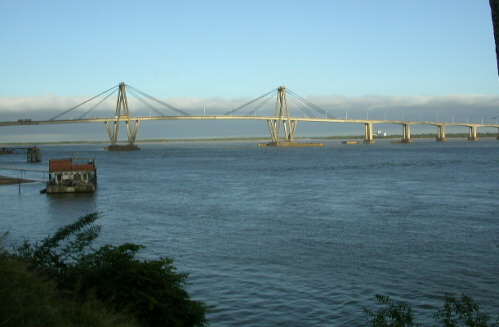
May 06
On the way to Iguazu
This is an easy trip only 600 km and the roads are good but we soon run in to slow moving
trucks because of all the forest be harvest here in the provinces of Corrientes and
Misiones. It a good thing Alfred is driving as he has more patience than me. This part of
Argentina is quite different since we soon run in to large forest areas with a lot of
clear cutting. No large multi national forest companies but a lot of lumber mills and
burning of waste. Hope they wont destroy all of for the sake of money. They do seam to
replant as they clear cut but I think most of it is fast growing alien trees.
At the first place we stop for gas, I buy a bottle of water. Big mistake since I think it
was "home made water" but I only drink a little before I realize it. Still I am going to
suffer a bit for next few days. If I had stuck to cerveza I would not have had this
problem.
We stopped in Posadas for lunch, not a particularly exiting town but a nice water front
with big houses and side walk restaurants. Even a local yacht club with big sail boats
but with the reservoir for a large hydro dam I think they will have some pretty fair
sailing there all year round.
Arrived in Pt Iguazu around 5 pm and checked in to the hotel without any problems. This
is not a town like the other ones we have visited so far. Little traffic and shopping
streets, but still people out walking and I can't believe that the macho guys here are
not into mufflerless cars. We learn later that people go to Brazil where the city is much
bigger and lively. We went in to a restaurant for a cup of tea and found the first place
so far where every one was smoking and we ended up sitting on the sidewalk freezing.
This is suppose to be the subtropical part of Argentina, and so far the coldest, because
of strong winds from the south. Wile we were drinking our cup of tea a car park right in
front of us, leaving a miniature poodle dressed to kill and looking very upset at being
left alone in the car. A few small native kids in bare feet were begging on the street.
When I went into the restaurant to pay the bill, and coming out, I gave the youngest one
two pesos. He looked rather surprised but did not say thank you and I wonder if he had to
share the loot with the rest of the gang.
At the hotel I made contact with a local birder and made arrangements to go birding with
him on Thursday.
"A Mans Beer in Posadas"

May 07
Tourist at the Famous Iguazu Falls(A must see if you visit Argentina)
We decided to spend the whole day being tourists at the famous Igazu Falls located in
Parque Nacional Iguazu and they are definitely impressive. It is all well organized and
somewhat commercialized, but still nothing compared to Niagara Falls. From the main
entrance, you take a train ride to the board walks leading to the largest of the many
falls and all the rest is walking up and down many stairs to view the rest of the falls
and Isla San Martin. I think more than half the people who visit Niagara Falls would be
in no shape to see this natural wonder. The falls are basically left in their natural
state with very few buildings close to the falls and all restaurants etc. hidden in the
semitropical forest surroundings. A short boat ride takes us to San Martin island where
one can climb steep steps to get a close view of the surrounding falls. There is a large
roost of Black Vultures there. We also saw many Great Dusky and Ashy-tailed Swifts flying
around the falls, plus Toco Toucans, to name but a few.
In one of the restaurants, a young women introduced Alfred to the famous Mate tea, which
many local people drink here. It's drunk from a special cup, through a kind of silver
"straw" and people bring there own cups into restaurants. The taste is somewhat like
spicy green Chinese tea, and here they drink it without sugar, telling us that in Buenos
Aires they sweeten theirs because it's too strong for them. When we leave around 5 pm we
are ready for a late siesta after all the walking and climbing.
Late dinner to night and I finally try the famous Surubi fish with a great white wine.
Very good and I can recommend it to anyone who likes fish.
May 08
"Iguazu Falls"

"More Iguazu Falls"
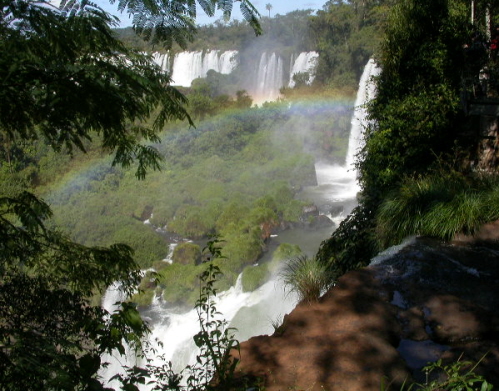
"Still more Iguazu Falls"
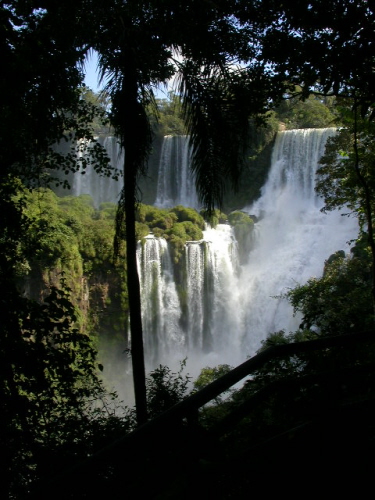
May 08
Birdwatching in the Jungle
Miguel, my local guide, picked me up at the hotel at 6 am and we headed for the Parque
Nacional Iguazu. It's only 5 degrees Celsius and very foggy when we drive in to the park,
park the car at the end of a trail, and start walking up a 6 km long trail. Birding here
is done using tape recordings and Miguel obviously knows where the different birds are
located. He played the tapes and was able to bring almost all the birds into view: the
only way to see them in such dense foliage. High lights were Blond-crested Woodpecker,
the tiny Ochre-collared Piculet, both Trogons and many good Flycatchers and Tanagers.
Tapir tracks in the mud, Jaguar droppings and only once did Migual tells me to watch out
for snakes, but I think they would have been a bit slow because of the low temperature.
I really enjoyed the birding and Miguel's knowledge about nature. At noon we were back at
the hotel for a couple of grande cerveza, and a final chat with Miguel.
In the afternoon, I visit the local Castillo family's garden, where they have several
Hummingbird feeders and attracted many hummers and in half an hour, I had 5 lifers. The
address is Fray Luis Beltran 150 and the family is very friendly, but only a young son
speaks some English.
Preparing for tomorrow we have an early dinner and are in bed 9.30 pm. It's very quiet
here, so I will have a good sleep and will need it for the next drive.
"Miguel the Birder in the Jungle"
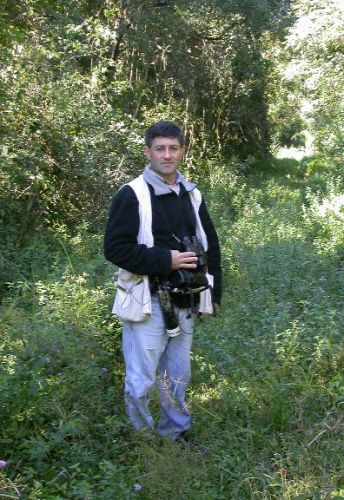
"Hummingbirds"
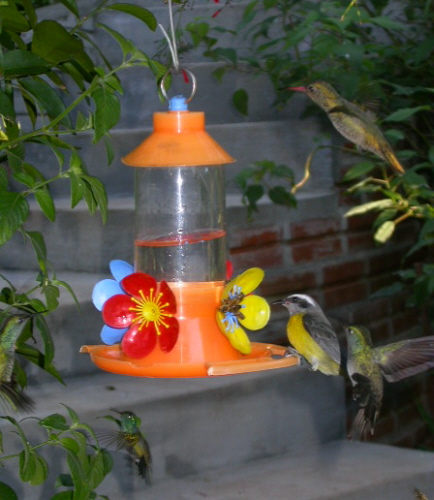
May 09
Back to Buenos Aires
Since we decided to stay an extra day in Iguazu, we are not stopping in Colon but driving
to BA the longest trip so far: 1200 km.
Get off to a good start just before 7 am but it is foggy for the first couple of hours
on Ruta 12 towards Posadas. This is the most direct route, a good road and has very
little traffic.
Just before Paradas we stop to visit one of the famous Jesuit ruins in San Iguacio.
Today it is only ruins but one can easy imagine from their size and organization, that
Argentina and the surrounding countries could have been completely different societies,
if the Jesuit had been left alone and not "kicked" out by the King of Spain. It would
have been a strange society with the single Jesuits living in their own quarters with a
large church, library, school and hospital surrounded by the native population living in
row upon row of stone townhouses and work shops.
After a quick breakfast we are off again, turning Southeast on Ruta 105 to 14. The
landscape starts changing as we enter the province of Corrientes again, flat, with large
cattle ranches. Half way down and now in the province of Entre Rios, I finally get a look
at my first flock of Rea's. The roads are excellent so we make good time, but for the
first time our papers are scrutinized at police stops. At one stop the officer informed
us that our Canadian drivers licences are no good but he finally let us continue but
told us to contact the Canadian consulate when we get to BA. As we get closer to Buenos
Aires, the traffic gets heavier, especially in terms of large trucks, and we are forced
to slow down. Just as it gets dark, we reach the divided highway taking us in to BA and
the traffic speed up again. We have trouble finding our Loi Suites Hotel because of the
way a street can change names and because of all the one way streets, but we finally
get there and we are exhausted. Quick dinner and to bed for me.
"The Jesuit Church"
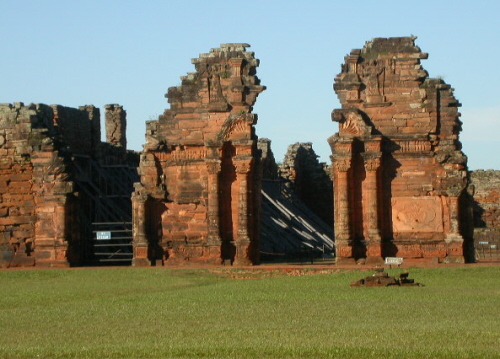
"Native Quarters"

May 10
Birding downtown Buenos Aires
Up early and I am going birding with Sergio at Costanera Sur Reserva Ecologica. It's
downtown and we simply walk down there from the hotel. Costanera Sur is man made from
the excavation of the large buildings in BA, similar to Leslie Spit in Toronto. This is
a great place to watch many different kinds of water birds. Even rails, but I was not so
lucky to see any but I did see Red-crested and Yellow-billed Cardinals to name a few and
my list of lifers is now at 152. I am always impressed when I can have good birding in
the middle of large cities. At one o'clock we are off to a massive Argentinean lunch in
a restaurant on the water front. Huge salad buffet and meat, meat, meat. Then back for
some more birding for gulls and ducks.
We go back to the hotel where I talk to Alec, another BA Birdingpal, on the phone and we
decide to skip birding tomorrow(I would probably only have add 4 or 5 new birds to my
list) but meet for lunch on Monday.
"Birding at Costanera Sur with Sergio the Super Pal"
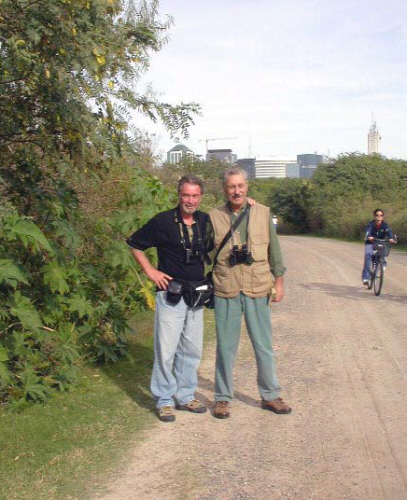
"Pampas Grass and Skyscraper"
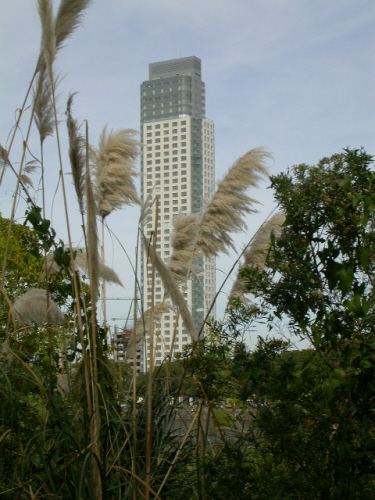
May 11
Tourist again in Buenos Aires
Again a fine day in BA. We have been very lucky with the weather during this trip. A bit
of rain on the way to Mendoza and some fog around Iguazu. Got up early and went for a
walk to take more pictures of the many fine buildings here. I bought the English Sunday
newspaper(Buenos Aires Herald) and found a nice little sidewalk cafe to have a cerveza
and read the latest news. Since Cordoba we have not had any English papers or TV news so
I am trying to catch up on the problems of the world.
Later Alfred and I visited the National Art Gallery. The old European masters were well
represented, but we think there should have been more Argentinean artists represented.
I have also started to take pictures of the beautiful doors into apartment buildings and
their garage, which usually are next to each other.
Did a bit of shopping for leather goods since cost is attractive but you have to be
careful or you will not get quality for your money.
I had dinner with Sergio, the Super Pal, to thank him for all the help he gave us
planning this trip, the money he saved us, and of course, the two days of birding.
The last evening of course called for red meat so we went to a fancy restaurant
specializing in grilling. I am sorry to say Buenos Aires, that even if the meat was
great, it still did not beat the steak in Mercedes and it was a lot cheaper there.
Sergio presented me with a Wichi carving(made by native Indian craftmen from the far
northwestern jungle in the provinces of Salta and Jujuy bordering with Bolivia) of
probably the most exiting bird of the trip, the Condor. Thanks Sergio. Come to think
about it, maybe the Blond-crested Woodpecker was the most exotic.
"Apartment Entrance in Buenos Aires"
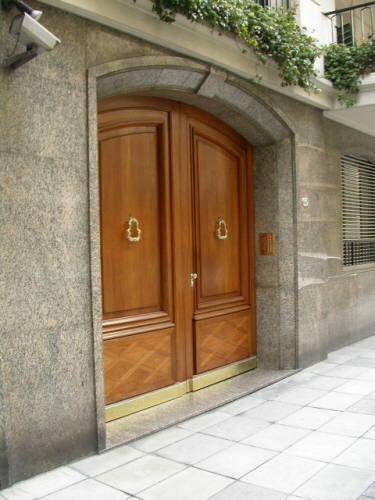
May 12
The last day in Argentina
Since our plane did not leave until 8 PM local time we had the whole day to relax and do
a bit of shopping and I had a pleasant lunch with Alec.
When we arrived at the airport and went through security etc. we where presented with a
$40 bill each for the pleasure of flying out. I still remember when you just showed your
boarding pas and boarded the plane. No security, extra cost etc. Will it ever come back?
All in all, both Alfred and I enjoyed our trip and would recommend it to anyone and
thanks again to the birdingpal's for making a great trip even better.
"Alec a local Birdingpal"

Knud Rasmussen
Toronto, Ontario, Canada
Visiting a Hummingbird garden at Iguazu Falls
by Superpal Sergio Corbert
Birders visiting the Iguazu area usually go birding in and around the "Iguazu National Park" and while being there they also give a look at the world famous Iguazu Falls. Yet
many do not know that on the Argentine side in the town of "Puerto Iguazu" there is a garden at a private home which is famous for the number and different species of Hummingbirds
it attracts. The place belongs to the Castillo family and they have arranged it in such a way that they have the year round plants blossoming in order to attract hummers. On the
branches of several bushes Mrs. Castillo has hanged feeders which are intensely visited not only by Hummingbirds but also by Bananaquits, Tanagers and Blackbirds (see picture).
In the trees that grow around the Castillo's home and its neighbourhood often one can see birds that are quite curious but reluctant to come down, therefore birders should also
look up into the trees to discover several species of Doves, Chalk-browed Mockingbirds, Chopi Blackbirds and even Red-rumped Caciques.
On last mid May while birdguiding at the Hummingbirds Garden we saw 8 different Hummingbirds species and the most striking sighting was that of a "Swallow-tailed Hummingbird"
considered very rare in Argentina as only two previous sightings of it were ever recorded before!

"Hummingbirds at The Castillo garden"
List of birds seen at the "Hummingbird Garden" at Puerto Iguazu:
- Eared Dove, Zenaida auriculata.
- Picui Ground Dove, Columbina picui.
- Ruddy Ground Dove, Columbina tapalcoti.
- Scaled Dove, Columbina squammata.
- Scale-throated Hermit, Phaethornis eurynome.
- Planalto Hermit, Phaethornis pretrei.
- Swallow-tailed Hummingbird, Eupetomena macrura.
- Black Jacobin, Melanotrochilus fuscus.
- Black-throated Mango, Anthracothorax nigricollis.
- Violet-capped Woodnimph, Thalurania glaucopis.
- Glittering-bellied Emerald, Chlorostilbon aureoventris.
- Gilded Sapphire, Hylocharis chrysura.
- White-throated Hummingbird, Leucochloris albicollis.
- Versicoloured Emerald, Amazilia versicolor.
- Bananaquit, Coereba flaveola.
- Sayaca Tanager, Thraupis sayaca.
- Violaceus Euphonia, Euphonia violacea.
- Chestnut-bellied Euphonia, Euphonia pectoralis.
- Green-headed Tanager, Tangara seledon.
- Blue Dacnis, Dacnis cayana.
- Saffron Yellow-Finch, Sicalis flaveola.
- Epaulet Oriole, Icterus cayanensis.
- Baywing, Agelaiodes badius.
- Shiny Cowbird, Molothrus bonariensis.
- House Sparrow, Passer domesticus.
Any visiting birder should call at the gate (see picture with the Welcome sign in the garden) and someone of the Castillo's family shall show him into the garden and then walk to
the feeders area where most of the hummers are seen.
Sergio Corbet."
Note: I have been there and even a non-birder will enjoy the garden. Any hotel in Iguazu can direct you to the garde. Knud Rasmussen
Trip Report Argentina – December 5 and 10 - 2004
by Birdingpal Sergio Corbert
LOOKING FOR SOUTHAMERICAN HARRIERS
Birdguiding is always a challenging affair as guides have to adapt to changing situations primarily caused by weather conditions and then by birders expectations. Birdguiding a
specialist that comes from far away to see, watch and photograph a determined species he is studying is something very delicate indeed! Generally speaking Don Scott is an avid
birder but his goal is to see and study personally all the existing Harrier species in the World. Having guided him to see the only 2 existing South American Harriers, he now has
seen traveling to different parts in the world 12 species of a total 16! I started planning carefully this birding trip about a year ago when Don told me that he had only about 2
weeks to accomplish his task and this should be sometime close to the year’s end. To most birders raptors are birds as any others although the Falcons and especially the Peregrine
Falcon just because of ancient falconry traditions may mean something more, but Harriers!? In our country we just see them flying in the fields and that’s it! Now Don wanted to
see our 2 Harrier species in their habitat and if possible nesting or rearing chicks. This meant that I had to dig into my “Raptors of the World” book (which because of its size
qualifies only into the German taschenbuch category) and thus find that the Cinereus Harrier migrates through the central South American continent and nests in southern Patagonia
while the Long-winged Harrier moves almost over all South America mostly nesting in the central Argentine wetlands and more to the north too. Because of the distances involved,
this obviously meant that finding one species nesting would necessarily mean that the other one would not be doing so.
Nancy and Ludie, a couple of birders I had birdguided on last year were now living in southern Patagonia and told me that in their area around San Julian they had often observed
Cinereus Harriers flying and roosting so there was a strong possibility of finding some of them even nesting. Don arrived on the first days of December so down south we went to
Patagonia in search of the Harriers. We stayed 5 days at San Julian and the weather treated us well, it was quite warm according to local people’s comments yet the never ending
wind which inspired Charles Darwin to call Patagonia “The Whispering Land”, very often made us feel miserable. We saw quite a number of Cinereous Harriers during our stay, mostly
all birds flying, hunting or apparently just circling seeking thermals. Making some changes in our watching strategies finally produced a rewarding find. While walking along a
bushy and small ravine, a female rose almost from under Don’s feet upon our approach and there on the ground quite concealed in the bushes we saw a nest with 3 week-old chicks in
it! Don was delighted so he made observations and took pictures of all. We soon left the nest and from not far away saw a male Cinereus Harrier coming in holding a prey in its
legs, it then tossed it to the on flying female that caught it legs up in the air and certainly took it to feed the chicks. What a sight!
On the next morning we took advantage of a boat trip within San Julian Bay guided by Natalia a local nature guide. She took us watching a colony of nesting Magellan Penguins and
Blue-eyed Cormorants, some wintering Red Knots, South American Terns, Blackish Oystercatchers and several other birds. Upon arrival to one of the nesting colonies, we were greeted
by a pair of Pale-faced Sheathbills that came running towards the boat as if greeting some old friends. We saw the Magellanic Penguins moving on the shore being harassed by Hall’s
Giant Petrel which would come from the sea gliding low above them probably choosing a strained fat chick to feed on. Seeing these majestic birds fly in the wind, with their long
wings stretched and gliding effortlessly without a wing beat is something that leaves you marvelled even during a long time after. While driving from Rio Gallegos to San Julian
and during our stay there, we managed to see some other birds too. Please find hereunder a list I made of different bird species seen during the 5 days stay while searching the
Cinereus Harriers.
We now moved north, back to the Pampas where in the low wetlands close to marshes, lagoons and ditches we could find the Long-winged Harriers. The first place visited was the
Otamendi Nature Reserve, then some days later we went into southern Entre Rios province where there were places with very typical Harrier habitats. We found it was useless to
look for any nests as we saw many juveniles flying, some already hunting on their own. During the forthcoming days we did some spectacular sightings of both males and females,
even of the darker phase of this species. While looking for Harriers in southern Entre Rios province, a male obliged gliding very close to us flying above a ditch along the road
so it allowed Don to take pictures of it during an almost incredible 2 miles long drive completely ignoring us, so concentrated it was while hunting! On our last day the lowlands
at Otamendi Nature Preserve produced some great sightings and Don got some very good pictures of several close flying Long-winged Harrier females. With all the materials obtained
Don happily left back to Ireland.
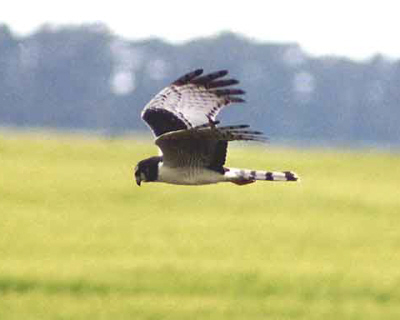
Long-winged male Harrier copyright Peter Nash's.
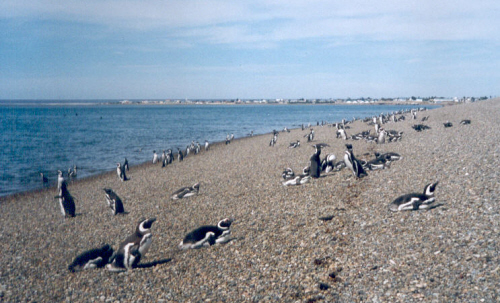
Magellanic Penguins colony on the shores of an island at San Julian Bay.

Pale-faced Sheathbills.
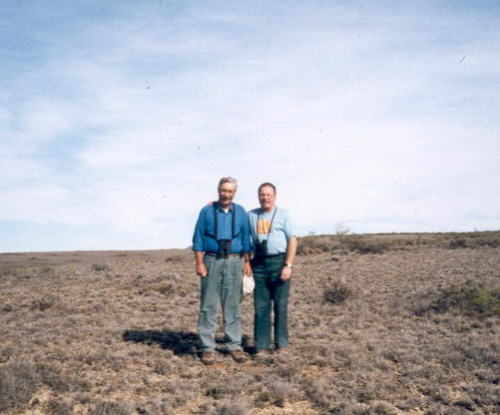
Don Scott and me standing in the Patagonian steppes on the lookout for the Cinereus Harrier.
List of birds seen while driving between Rio Gallegos and San Julian and around San Julian between December 5 and 10 - 2004. Target bird: Cinereus Harrier.
- Darwin´s Rhea, Rhea pennata.
- Elegant-crested Tinamou, Eudromia elegans.
- Magellanic Penguin, Spheniscus magellanicus.
- Great Grebe, Podicephorus major.
- Hall’s Giant Petrel, Macronectes halli.
- Antarctic Petrel, Thalassoica antarctica.
- Red-legged Shag, Phalacrocorax gaimardi.
- Neotropic Cormorant, Phalacrocorax brasilianus.
- Rock Shag, Phalacrocorax magellanicus.
- Imperial Shag, Phalacrocorax atriceps.
- Black-crowned Night Heron, Nycticorax nycticorax.
- Black-faced Ibis, Theresticus melanopis.
- Chilean Flamingo, Phoenicopterus chilensis.
- Coscoroba Swan, Coscoroba coscoroba.
- Black-necked Swan, Cygnus melanocrypha.
- Upland Goose, Chloephaga picta.
- Crested Duck, Lophonetta specularioides.
- Flying Steamer Duck, Tachyeres patachonicus.
- Red Shoveler, Anas platalea.
- Chiloe Wigeon, Anas sibilatrix.
- Speckled Teal, Anas flavirostris.
- Yellow-billed Pintail, Anas georgica.
- Rosy-billed Pochard, Netta peposaca.
- Cinereus Harrier, Circus cinereus.
- Black-chested Buzzard-Eagle, Geranoaetus melanoleucus.
- Variable Hawk, Buteo polyosoma.
- Southern Crested Caracara, Caracara plancus.
- Chimango Caracara, Milvago chimango.
- Aplomado Falcon, Falco femoralis.
- Peregrine Falcon, Falco peregrinus.
- White-winged Coot, Fulica leucoptera.
- American Oystercatcher, Haematopus palliatus.
- Blackish Oystercatcher, Haematopus ater.
- Magellanic Oystercatcher, Haematopus leucopodus.
- Southern Lapwing, Vanellus chilensis.
- Hudsonian Godwit, Limosa haemastica.
- Red Knot, Calidris canutus.
- White-rumped Sandpiper, Calidris fuscicollis.
- Least Seedsnipe, Thinocorus rumicivorus.
- Pale-faced Sheathbill, Chionis alba.
- Dolphin Gull, Larus scoresbi.
- Kelp Gull, Larus dominicanus.
- South American Tern, Sterna hirundinacea.
- Common Tern, Sterna hirundo.
- Antarctic Tern, Sterna vittata.
- Cayenne Tern, Sterna eurygnatha.
- Short-eared Owl, Asio flammeus.
- Scale-throated Earthcreeper, Upucerthia dumetaria.
- Band-tailed Earthcreeper, Eremobius phoenicurus.
- Blackish Cinclodes, Cinclodes antarcticus.
- Plain-mantled Tit-Spinetail, Leptasthenura aegithaloides.
- Chocolate-vented Tyrant, Neoxolmis rufiventris.
- Rusty-backed Monjita, Neoxolmis rubetra.
- Cinnamon-bellied Ground Tyrant, Muscisaxicola capistrata.
- Austral Negrito, Lessonia rufa.
- Chilean Swallow, Tachycineta meyeni.
- Blue-and-white Swallow, Notiochelidon cyanoleuca.
- House Wren, Troglodytes aedon.
- Austral Thrush, Turdus falcklandii.
- Patagonian Mockingbird, Mimus patagonicus.
- Patagonian Yelow-Finch, Sicalis lebruni.
- Rufous-collared Sparrow, Zonotrichia capensis.
- Long-tailed Meadowlark, Sturnella loyca.
- House sparrow, Passer domesticus.
Sergio Corbet.”
Trip Report Argentina – November-December 2005 Trip Report Argentina – 26 February – 9 March 2004 Last update 25/10/2012
by Birdingpal Jim Day
Hi, Friends:
I've just returned from a four-week-plus trip to Argentina, and I saw a lot of birds, plus a few other animals. The first eight days were spent in the
northwest of the country. Then I rested for awhile with family in Cordoba and did some birdwatching there, too. Next site was Esteros de Ibera, a
provincial park in Corrientes in the northeast. And finally I visited Patagonia for the first time. In the northeast, I was with Ted Buhl, whom I met
last year in Argentina. He arranged with guides Carlos and Silvia, plus bird guide Jose, for us to tour in C&S's Land Rover all the way to the Bolivian
border, and up to 4,550 meters of elevation, almost entirely in Jujuy Province. This is a land of earthcreepers, miners, chat-tyrants, ground-tyrants,
canasteros. And lots of llamas and vicunas, and even wild chinchillas. On our second day, we saw perhaps the bird of the trip, Torrent Duck, a pair in the
Yala River swimming upstream. At the same site we found Rufous-throated Dipper, though I got just glimpses. At Laguna de Pozuelos we saw all three S.
American flamingo species plus my first ratite, Lesser Rhea. We drove next to one and it outran us. In Yavi, I found a nest of Wedge-tailed Hillstar,
rarely seen south of the Bolivian boder, with the female sitting on eggs and the male nearby. The road east to Victoria was outstanding, with two seedsnipes,
Mountain Parakeet, Elegant Tinamou. Earlier, a bit farther south in Jujuy, we had found Giant Hummingbird, and saw a pair engaging in an apparent nuptial
flight, rising and buzzing, dipping and darting, in tandem. Another notable sighting was Yellow-billed Tit-Tyrant, with "horns" and bold black markings
below. This was from an outdoor restaurant table in Purmamarca (I was eating a delicious llama stew.) The unbelievable Red-tailed Comet, a hummer I first
saw last year in Cordoba, also entertained us during lunch.
I'll now switch to Esteros de Ibera, in Corrientes, an isolated warm marshy area. The place is excellent and highly recommended. I suggest you find the
official park guide Ariel Sanches, who knows the birds and even knows most of the English names. He'll take you on boat rides in the marshes. Scarlet-headed
Blackbird is the signature bird of the park, and from the boat you can also see Donacobius, a large, beautiful member of the wren family. I also suggest
you find Jose Martin (not the national hero), who lives in the town of Carlos Pelligrini in the park but also has a private ranch some 40 km east of the town
with his own private reserve; I saw at least three species only at his ranch, and they were great birds: Yellow Cardinal, Striped Cuckoo and White-browed
Warbler. Also driving with him on the road that leads to Mercedes, I saw the Strange-tailed Tyrant, which is indeed strange, plus Red-winged Tinamou. And how could
I forget Greater Rhea, at least seven? And the Firewood Gatherer, an ovenbird ally which gathers sticks for his nest.
My last day in Carlos Pelligrini was fiesta, and here was a gaucho parade in the morning, followed by a giant steak cookout for all in the park along the
marsh. The celebration ruined my chance of finding White Woodpecker, but I did see Solitary Cacique during the festivities.
On to Patagonia, and the Argentine airline strike ended just in time. I stayed in Puerto Madryn, and made one-day excursions to Punta Tombo and to the
Valdes Peninsula. The first site provided hundreds of Magellanic Penguins, Brown Skua, and the fantastic Dolphin Gull in breeding plumage. I'm not normally
a gull fancier, but this one is special, with a creamy body, some kind of head plume, red legs and a piercing red eye. This is where I also got my first of
two sightings of Elegant Crested Tinamou. It was the end of whale season (the rare Southern Right Whale breeds here) and we didn't see any, but we did see
Elephant Seals. Plus Guanaco and a strange mammal called a cavy (mara in Spanish); it looks like a small kangaroo, and it hops, but it's a regular mammal,
not a marsupial.
All in all, a wonderful trip in which nothing went wrong. There were, of course, some misses, like Black-bodied Woodpecker,which I also searched for last
year in Cordoba. And Snowy Sheathbill, which I expected to see with the seals. But one has to leave something for next year. Also missed Sharp-tailed
Streamcreeper, which some of our group saw but I only heard. Don't you love the name? And it was in a stream bed.
Here are some of the birds seen. I tend to write down the new species seen, which totaled 130 this year (on top of 170-some last year in Argentina).
But there were also great species previously seen, such as Jabiru, Buira Cuckoo, Southern Screamer (numerous in Ibera), Andean Condor in the northwest,
King Vulture, Smooth-billed Ani riding on capybaras in the marshes, three kits (hook-billed, snail and Swallow-tailed), Aplomado Falcon, and a couple of
familiar Texas faces, Roseate Spoonbill and Vermilion Flycatcher.
Fulvous-headed Brush-finch (Jujuy)
White-crested Elaenia
Cordilleran Canastero
Crfeamy-breasted Canastero
Slaty-headed Parrot
Rosy-billed Pochard
Rusty-browed Warbling-Finch
Red-crested Finch
cihlean Swallow
Andean Lapwking
Rufous-throated Dipper
Bar-winged Cinclodes
Andean (Plumbeous) Tyrant
Streak-throated Rush-Tyrant
Spot (Freckle)-breasted Thornbird
Torrent Duck
Puna Ibis
Lake Duck
Andean Ruddy Duck
Brown Pintail
Andean Gull
Patagonian Mockingbird
Band-tailed Sierra-Finch
Plain-mantled Tit-Tyrant
Spectacled Tyrant (also in Patagonia)
Wren-like Rushbird
White-tipped Plant-Cutter
Ash-breasted Sierra-Finch
Brown-backed Mockingbird
Giant Hummingbird
Wedge-tailed Hillstar
Mourning Sierra-Finch
Andean Swift
Black-hooded Sierra-Finch
Rufous-naped Ground-Tyrant
White-browed Chat-Tyrant
Yellow-billed Tit-Tyrant
Spot-billed Ground-Tyrant
Grey-hooded Sierra-Finch
Puna Miner
Common Miner
Cordoba Canastero
Greenish Yellowfinch
Mountain Caracara
Puna Yellowfinch
Bright-rumped Yellowfinch
Rock Earthcreeper
Ornate Tinamou
Plumbeous Sierra-Finch
Rufous-bbellied seedsnipe
Andean Swallow
Andean flicker
Mountakin Parakeet
Red-backed Hawk
Whtie-fronted Ground-Tyrant
Citron-headed Yellowfinch
Bare-eyed Ground-Dove
(still Jujuy)
Bolivian Warbling-finch
Plain-breasted Earthcreeper
Red-backed Sierra-Finch
Grey-breasted Seedsnipe
Cinereous Ground-Tyrant
Straight-billed Earthcreeper
Buff-breasted Earthcreeper
Plain-colored Seedeater
Andean flamingo(Laguna)
de Pozuelos
chilean Flmaingo
Plna flamingo
andean Goose
Puna Plover
Andean Avocet
Crested Duck(also seen in Esteros)
Lesser Rhea
Andean (Rufous-backed) Negrito
golden-spotted Ground-Dove
Jujuy
Puna Hawk
Dark Brown Swift(Calilegua Park, Jujuy)
Guira Tanager
Slaty Elaenia
Rusty-collared Seedeater
Cliff Flycatcher
Red-crested Cardinal(Esteros)
de Ibera
Pearly-vented Tody-Tyrant
"
Greater Thornbird
Long-winged Harrier
Yellow-rumped Marshbird
Striated Heron
White-necked Heron
Sooty Tyranulet
Unicolored blackbird
Donacobius
Scarlet-headed Blackbird
Rufescent Tiger-heron
Greater Rhea
Brown-and-Yellow Marshbird
Green-winged Saltgator
black-collared Hawk
Heard - Green-backed Becard
White-faced Tree-Duck
Blue-billed black-Tyrant
Chestnut Seedeater
Whtie-browed blackbird
Firewood Gatherer
White-browed Warbler
Striped cuckoo
Golden-breasted Woodpecker
Yellow Cardkinal
Heard -- White-bellied Nothura
Marsh Seedeater
White-collared Seedeater
Red-winged Tkinamou
Gray Monjita
Lesser Grass-finch
solitary Ccique
Yellow-winged Blackbird(BsAires)
Black-necked Swan(Patagonia)
Great Grebe
Brown-hooded Gull
austral Thrush
elegant Crfested Tinamou
Magellanic Penguin
Kelp Gull
Southern House Wren
Great (Brown) Skua(many, one eating penguin)
Dolphin Gull
Giant Petrel
Blackish Oystercatcher
Rock Cormornt
King Cormorant
My recent one-month trip to Argentina, my fifth to that country, was more relaxed than previous birding trips there, with a heavy dose of visiting relatives in Cordoba, an excess of eating, visiting vineyards and imbibing the excellent wines, some spectacular scenery, and, oh yes, a modicum of birdwatching. I returned yesterday, January 18, from this one-month endeavor,
and am now looking out the window at snow falling here in Plovdiv, Bulgaria, in contrast to the warmth of the austral summer I have been enjoying.
From my base in the delightful town of La Cumbre, Cordoba, I traveled to Mendoza, the wine center, and nearby Mt. Aconcagua,
the world's highest peak outside the Himalayas; and north to the provinces of Salta, Jujuy, Tucuman and Catamarca. A much-desired return to Esteros de Iberra in the northeast had to be called off because of the vagaries of the Argentine transportation system (which otherwise served me very well). And before I even embarked on this trip, I had to abandon plans to visit Southeast Brazil because of the difficulty -- for an American living in Bulgaria -- of obtaining a visa to enter that country. But Brazil remains high on my list of places to visit in the future.
I managed to add only nine new birds to my list, which now totals 2,286. These include: South American Stilt (Jujuy), Greater Yellowfinch (Aconcagua), Collared Forest-falcon (J), Black-banded Woodcreeper (J), Variable Antshrike (J), Alder Parrot (J), Burrowing Parrot (Tucuman), Gray-hooded Parakeet (Catamarca) and Salinas Monjita (C).
The last-named, an endemic, was seen in a dramatic setting virtually within walking distance of the pleasant town of Santa Maria, The habitat is what I would describe as badlands, such as might seen in the Dakotas of the U.S.: sharply defined hills and mountains of various colors that changed with the position of the sun. Joining these hills are dry river beds and something akin to salt flats. A bit farther north, in the fantastic canyons known as Alemania in Tucuman, I first saw Burrowing Parrot, a good-sized colony that had dug their homes out of the sandstone castles along the highway. Also in these canyons I saw an old friend, the brownish-chestnut Cliff Flycatcher, which I had first seen in 2005 near Yavi, along the border with Bolivia.
In Jujuy, I stayed with Calos and Silvia on their ranch known as Portal de Piedra
But perhaps the highlight of my time with Carlos and Silvia was our visit to the roost of the threatened Alder Parrot, on the edge of the town of Fuerte, alongside a corral in which gauchos were breaking horses. These birds are being studied by a team from Jujuy University that spent one night at the ranch with us before heading up into the mountains with pack horses. One of their team provided an entertaining preprandial guitar serenade of Argentine folk music, accompanied by wine and the ubiquitous but delicious empanadas.
On a day's visit from Mendoza to the base of Mt. Aconcagua, two sightings are worth mention, apart from the mountan itself. I was completely thrown by the southern race of an exceedingly common bird, Rufous-collared Sparrow. It took me at least an hour to realize what I was looking at and hearing on all sides. And on the ride back to the city, we had an immature Andean Condor flying alongside the bus, affording a good look. Also along the way I spotted a bird first seen farther north some years ago: White-winged Black Tyrant.
Another interesting vignette, previously described to a couple of you, took place near the house in which I was staying in La Cumbre, Cordoba. Two Green-barred Woodpeckers (the Southern/Western form previously known as Golden-breasted Woodpecker and still considered by some a separate species) went into a display. The two were perched close to each other, and moving in a jerky manner as if they were clockwork toys, often standing stock-still for seconds at a time. This went on for several minutes.
My fourth attempt to see Black-bodied Woodpecker ended as the first three did, without success. But I thinking I heard three of them near a river at the mountain Uritorka, in Capilla del Monte in Cordoba. Despite climbing down a very steep bank, I could not glimpse the birds.
I should also mention my visit to the archeological museum known as MAAM in the city of Salta. There on display, on a rotating basis, are the bodies of three Incas uncovered ten years ago at the top of the mountain known as Llullaillaco (6,739 meters), which lies a bit to the west in the high Andes at the border with Chile. The body (they are not mummies but have been preserved by the cold and ice) I saw is known as the Virgin. The only organ missing from the bodies is the spleen, which is the first to deteriorate because of its make-up. The bodies date to the second half of the Fifteenth Centure, if I was informed correctly.
If you would like details on any of the above, just write me.
Jim Day
jimday7(AT)yahoo.com
by Birdingpal Ron Bartlett
Go to www.vjv.com, click on Natural History and you find Argentina’s Natural World, which on 26 February 2004 cost £1395 plus single supplement of £195.
1.
We flew from Gatwick to Madrid and on to Buenos Aires, due to strong headwinds it was necessary to re-fuel at Sao Paulo, Brazil resulting in our landing at
about 10 am instead of 06.45am.
.
There was included a City Tour during the afternoon, so my planned trip to the Costanera Sur Nature Reserve had to be put on hold.
The Hotel de las Americas was comfortable , the food fabulous and inexpensive. The wardrobe doors had locks which I did not use, resulting in my winter
coat going missing.
House Sparrows were everywhere, while Rufous Bellied Thrush , Chalk Browed Mockingbird and Rufous Hornero, the national bird ,were on all the grassy bits.
Near Evita’s tomb had Green Winged Saltator. Near the Zoo and Botnanical Gardens in the Palermo district was a nice lake with waterfowl but the guide Hector,
who was not interested in natural history, refused to stop for even a few minutes, which did serious damage to his tip.
Next morning, there was a further included excursion to Tigre and the Rio Plata Delta. Visions of a empty bird filled landscape were thwarted as the whole
part we visited was built on, but did get Cattle Tyrant and Brown Throated Chachalote on lawns and Neotropic Cormorant and Great Kiskadee around the boat.
After a superb steak at the hotel, I got a taxi to the Costanera Sur Nature Reserve on the opposite side of the docks, the ride cost under £1.50 and took
about 15 minutes. At the main entrance there was a sound system belting out rock, lots of stalls and crowds of people, it did not get much better inside,
constantly dodging mad cyclists. However the birds were great. First there is a lake approx 1 mile long and 150 yards wide, with coots and ducks as far as
the eye can see, herons and egrets stalk the margins. Coots and ducks were being fed from the near bank with Coscoraba Swans further out, there were more
birds including Lake Duck on a small island. Walking along the causeway to the entrance, stopped to watch a Coypu when a Pinneated Bittern flew close, there
were also numbers of White Tufted Grebes. There were White Winged and Red Gartered Coots in numbers but got the only Red Fronted Coot of the trip. At the
Visitor Centre, turned left, although there were birds in every bit of hedge and flying above, decided to take the other fork as there appeared to be less
people. There were marginally fewer but one was dodging cyclists the whole time. There was another large lake on one side and dry fields the other, I turned
off the main path, where there was a patch of bushes which attracted three species of hummingbird, including a Scale-Throated Hermit, indicated in the book
as further north, but could not have had better views. Over the fields flew an Alplomado Falcon and the Lake.
2.
Snail Kite. Every likely spot yielded seedeaters, finches etc. My projected 2 hours there had stretched to 4 and the park was about to close . had a quick
peak up a small bridge with locked gate at the end, beneath was a shallow pond covered in vegetation with Wattled Jacana, Limpkin, Plumbeous Rail and
juvenile Wood Stork with Guira Cuckoos a few yards from picnicers. Sat down outside the gates to see if there were birds flying in to roost , being Ringed
Kingfisher and Striated Heron. Recorded 0ver 80 species here, unfortunately the Park is closed on a Monday, projected as a further visit.
Next morning, it was the optional excursion to an Estancia on the Pampas, gaucho show, tango, music, horse riding and an “asado”, or roast meat barbeque all
for US$23 , including 1.25 hours each way on a coach, in actual fact the pampas was the first bit of countryside outside the city. After Chimango and
Crested Caracaras along the road, had Cattle Egret, Southern Lapwing in the fields and Bay Winged Cowbird in the trees. It was a most enjoyable day , the
meal included unlimited drinks as well as a considerable portion of cattle, salad and ice cream, so drew a veil over the horse riding!!
Was now up to 106 species, and it was up at 4.30am for the flight to Trelew in Patagonia. Arriving at 9.20am, we were soon on the coach heading for the
Magellanic Penguin colony at Punto Tomba. Our guide was now Pili who was enthusiastic and knowledgeable about wildlife, the coach slowed and in front was a
large flock of Lesser Rhea then stopped near a farm for Elegant Crested Tinamou and Long Tailed Meadow Larks. We also saw several Guanaco’s the local Llama,
which we were to see throughout Patagonia in good numbers.
An hour and a half and we were arriving at Punto Tomba, where there were 1 million Magellanic Penguins, confiding little fellows, other seabirds included
Giant Petrels, Great Grebe, White Headed Steamer and Crested Ducks. A Spot-Winged Falconet flew by at close range. It took 150 steps to get down to the
beach, which was a mistake as one could see the birds better with a ‘scope from the top and there were only a few seals down there making rude noises, my
legs were never the same again. Most of the Elephant Seals had left so dipped on Snowy Sheathbill. Lunch at the local café cost about £1.50 for empanadas
(small pasties filled with various meats), a fresh from the oven fruit tart and drinks! .On the way back to Puerto Madryn, we visited a Welsh settlement
called Gaiman, where they still speak Welsh after well over 100 years. We had an enormous tea in a beautiful tearoom called Ty Gwyn – look you!! The fields a
round there were wet with good birds of prey including Cinerous and Long Winged Harrier.
Back at Puerto Madryn there was a long pier almost opposite our hotel, along which I dragged my aching legs, at the end was a structure with 3 species of
cormorant while alongside were Flying Steamer Duck , with various gulls and terns. Did not think much of the tiny fish being caught.
Next day, we were on the included trip to the Valdes Peninsula with its low scrubland, cliffs and beaches, seeing Patagonian Yellow Finch and Least
Seedsnipe en route.. Viewing galleries had been built on the cliffs overlooking bays, soon had American Oystercatcher (at last) along with Blackish
Oystercatcher, Cayenne and South American Tern, Olrog’s and Dophin Gull with more cormorants. It was out of season for the Southern Right Whales and our
proposed boat-ride was cancelled due to strong breeze and rough seas. We had a stop for Burrowing Owl(at last) and Mara, a cross between a deer and hare,
which can also be seen at Wingham Bird Park, near Canterbury, (the Mara not the Burrowing Owl).
3.
Another early morning flight,saw Austral Pigmy Owl on a roadside post, this time to El Calafate met by new guide Gaby, another wildlife enthusiast.
The Hotel Bahia Redondo was 100 yards from Lago Argentino, where the corner of the lake had small shrub and reed covered islands and in nearby fields were
shallow lakes with Southern Wigeon and Ringed Teal. On the Lake were Black Necked Swans and a good selection of ducks. This morning we suffered the only
rain of the trip which stopped at lunch-time while I was sampling a large lunch followed by Liquor de Calafate a pleasant drink made from the berries of the
Calafate Bush from which jam is also made. Both can be obtained at the Internet Café and at the Airport. Repeated the walk in the afternoon, picking up
Upland and Ashy Headed Goose in a field along with Patagonian Tinamou. Black Faced Ibis’s flew in, perching on a roof.
Next day, I went to the Estancia Alicia for sheepshearing etc a huge meal of barbequed lamb and a birdwatching walk around the lagoon, which held Hooded
Grebe along with Lake Ducks and Coot. Andean Condor can be seen from here but not today.
Back at the Hotel, walked along to fields with streams alongside the lake, there were plenty of Upland Geese also Tawny Throated Dotterel and a flock of
Correndera Snipe, also had Bi-Colored Hawk, White Throated Hawk and Rufous Tailed Hawk.
Next day it was the included excursion to the Glacieros National Park and Perito Merino Glacier. We stopped on way to watch Chilean Flicker and White
Throated Caracara. The glacier was spectacular, with the calving (lumps breaking off sounding like thunder, unfortunately, this always happened when I had
raised bins looking for or at a bird. After an Andean Condor floating down the valley , A noisy flock of Austral Parakeets were in evidence the whole time
also had the local hummer Green Backed Firecrown while eating the hotel packed lunch. White Crested Alaenias were common, while a walk in woodland revealed
Thorntailed Rayadito and Striped Woodpecker. Birded more woodland while others went on boatrides, but only had a couple of earthscrapers and shrike tyrants,
there were also many American Kestrels.A hectic half hour at the hotel and we were off to the airport for the 3 hour flight to Buenos Aires arriving at
11.30pm, finally getting to bed at 1am.
4.
Packed a small bag for the trip north to the !guassu Falls, arriving at the Sheraton Hotel at lunchtime, after another hectic half hour, we set off to walk
down through the hotel grounds to the Falls. In the crowds, I was tripped by a future Argentine footballer, falling heavily onto concrete, the first thing I
checked were my bins, which were OK, but I was severely bruised down the left side.Having been helped up by Stephanea, our new guide and the other members
of the party, limped on to the falls. There were hundreds of Turkey Vultures and had good close views of Plush Crested Jay. Sadly, the middle of the day
here is a waste of effort as there are very few birds active. Had a very pleasant and inexpensive late lunch at a restaurant between the hotel and the falls.
At about 5.30pm , birds began to appear, so swallowed some pain killers and limped out into the garden, had 3 species of toucan, tanagers, parrots,
flycatchers, Blackbirds and raptors.
Despite a back spasm in the bathroom, dosed up with pain killers, was out on the lawns at dawn, where there were similar birds but had Field Flicker and
Saffron Toucanet. Other guests saw a Black Fronted Piping Guan on the lawn. At 8am we were off to the Brazilian side of the falls, saw a Feral Pigeon in
Paraguay! Shortly after the Brazilian border Smooth Billed Anis began to appear on wires. At the Brazilian side of the falls, had Muscovy Duck, Anhinga and
Violacious Quail Dove with some spectacular views . While the others went on a boat trip around the falls, Stephanea arranged for me to be taken to a Bird
Park. There was a good selection of South American birds inside the enclosures, including Southern Screamer, which is a much lighter gray than shown in the
fieldguide. Outside the cages had Dusky Legged Guan, Swallow Tanager, Epaulet Oriole amongst others. The restaurant was very good, the banana split boasted
4 scoops of ice cream.
After a long wait at the border we were whisked back to the airport for the return flight to Buenos Aires, due to the lack of time and injuries dipped on
the large red crested woodpeckers.
The flight home was late evening, the Costanera Sur being closed on a Monday, decided to bird the Ribera Norte Nature Reserve , south of Tigre. A taxi to
Retiro Station (£1), half an hour on a train to Barthalome Mitre (15p), a 600 yard walk to Maipu station for the Tren de la Costa to Los Barancos (60p
return) across the lines, left and then right and I was there. Set off around the trail, when met the warden. The marsh is well and truly overgrown with
woodland and rushes but there were plenty of birds including White Throated Hummingbird, Glittering Bellied Emerald, Many-Coloured Rush-Tyrant and 2
antbirds, Grey Necked and Giant Wood Rail called loudly. You could only get halfway round to the Rio Plata due to contaminated water on the other side
After a cup of Mate with the warden and his two girl assistants, one of whom spoke English, I stopped off at Peru Beach, half way back to the station for a
superb lunch that sustained me until the airline grub. A walk round a beach area yielded Maguari Stork, White Necked Heron and Black Crowned Night Heron
among reed beds...
5.
Back at Retiro, said hang the expense, so took a £1.50 taxi ride for a last look at Costanera Sur from the lakeside. After Green Kingfisher and Ringed Teal,
it was time to get back to the hotel, for a wash in the gents and coach to the airport.
I had thoroughly enjoyed the tour which was well organised by South American Tours. Boarding passes were handed out before leaving for the airports so no
checking in. I had no stomach trouble. Breakfasts were included and with the enormous lunches did not eat in the evenings after the second night. There was
one morning of light rain at El Calafate, otherwise the weather was sunny and warm, hot at Ignaccu, athough it was quite windy in Patagonia. It was a lovely
day for the excursion to the Perito Merino Glacier, had to remove thermal underwear in the back of the coach much to the amusement of Gaby and the driver..
Apart from our arrival in Buenos Aires, all the Aerolinas Argentinas flights were on time. The local planes had more legroom then the international ones,
which were cramped if you are 6ft1in, the aisles were also extremely narrow.
All the hotels were comfortable with good food and service. We changed dollars into pesos which were 5 to the £. Malaria tablets were not required – insects
were no problem. There were nine other people in the party who became more interested in birds as we went along, writing them down, they also wound me up
about the Guan, that they saw and I missed!!
Finished with 263 species of which 190 were lifers, the time at Ignaccu was far too short, though Travel Collection have a trip with 4 nights in Buenos
Aires and 4 nights at Ignaccu, so could put that right sometime.
CONTACTS
Voyages Jules Verne ……..www.vjv.com
South American Tours……info@satbue.com.ar
BIRD LIST
COSTANERA SUR AND BUENOS AIRES
White Tufted Grebe
Pied Billed Grebe
NT White Necked Heron
Neotropic Cormorant
Magueri Stork
Rufescent Tiger Heron
Coscoroba Swan
Great White Egret
Black Necked Swan
Snowy Egret
Rosy Billed Pochard
Brown Pintail
Lake Duck
Kelp Gull
S.Crested Caracara
White Tipped Dove
Chimango Caracara
Great Kisskadee
Red Gartered Coot
Southern House Wren
Red Fronted Coot
Eared Dove
Wattled Jacana
Bran Coloured Flycatcher
Picazuro Pigeon
Cattle Egret
Piqui Ground Dove
Savannah Hawk
Guira Cuckoo
White Tailed Hawk
Green Barred Woodpecker
Rufous Collared Sparrow
Field Flicker
Gray Breasted Martin
Rufous Hornero
Limpkin
White Crested Tyranulet
Blue and White Swallow
Cattle Tyrant
Southern Rough Winged Swallow
Masked Gnatcatcher
Red Eyed Vireo
Rufous Bellied Thrush
Least Grebe
Creamy Bellied Thrush
Striated Heron
Blue Tufted Starthroat
Ringed Kingfisher
Blue Billed Black Tyrant
Turkey Vulture
White Winged Black Tyrant
Wood Strork
Bay Winged Cowbird
Franklins Gull
Chalk Browed Mockingbird
Saffron Finch
White Banded Mockingbird
Shining Cowbird
Rusty Collared Seedeater
American Black Vulture
Great Pampa Finch
Crowned Slaty Flycatcher
Black Capped Warbling Finch
Bat Falcon
Black & Rufous Warbling Finch
Snail Kite
Chestnut Capped Blackbird
Moorhen
Chilean Swallow
Common Starling
White Rumped Swallow
House Sparrow
Many Coloured Rush Tyrant
Feral Pigeon
Glittering Bellied Hummingbird
Muscovy Duck
White Tipped Plantcutter
Green Winged Saltator
Short Billed Canastaro
Red Rumped Warbling Finch
Brazilian Duck
Greater Wagtail Tyrant
Tawny Headed Swallow
Plumbeous Rail
Spotted Flanked Galinule
Gilded Hummingbird
Chequered Woodpeacker
Small Billed Alaenia
Warbling Dorito
Swainsons Flycatcher
White Winged Coot
Pinneated Bittern
Curl Crested Jay
Blue Crowned Parakeet
Double Collared Seedeater
Grassland Sparrow
Screaming Cowbird
Solitary Cacique
Brown & Yellow Marshbird
Firewood Gatherer
Brown Chachalote
Wrenlike Rushbird
Aplomado Falcon
Yellow Browed Tyrant
TRELEW , PUERTO MADRYN ETC
Darwins Tinamou
Lesser Rhea
Elegant Crested Tinamou
Southern Giant Petrel
Great Grebe
Cinerous Harrier
White Chinned Petrel
Bay Winged Hawk
Magellanic Penguin
Black Chested Buzzard Eagle
Rock Cormorant
American Kestrel
Gunay Cormorant
Bar Winged Cinclodes
Blue Eyed Cormorant
Laughing Gull
King Cormorant
Bonapartes Gull
Crested Duck
Royal Tern
Flying Steamer Duck
Sharp Shinned Hawk
White Headed Steamer Duck
Long Winged Harrier
American Oystercatcher
Blackish Oystercatcher
Least Seedsnipe
South Polar Skua
Dolphin Gull
Band Tailed Gill
Olrog's Gull
Brown Hooded Gull
South American Tern
Snowy Crowned Tern
Cayenne Tern
Burrowing Parrot
Burrowing Owl
Common Miner
Short-billed Miner
Band Tailed Earth Creeper
Black Crowned Mojita
Hellmayrs Pipit
Correndera Pipit
Patagonian Yellow Finch
Grey Hooded Sierra Finch
Carbonated Sierra Finch
Long Tailed Meadow Lark
Spot Winged Falcon
Patagonian Mockingbird
Austral Thrush
Northern Giant Petrel
Flightless Steamer Duck
El CALAFATE
Rusty Backed Mojita
Silvery Grebe
Patagonian Tinamou
Silver Teal
Hooded Grebe
Black Winged Ground Dove
Black Faced Ibis
White Crested Alaenia
Ashy Headed Goose
Bank Swallow
Upland Goose
Southern Martin
Speckled Teal
Southern Wigeon
Red Shoveller
Andean Condor
Bi Coloured Hawk
White Throated Hawk
Rufous Tailed Hawk
White Throated Caracara
Tawny Throated Dotterel
Correndera Snipe
Austral Parakeet
Austral Pygmy Owl
Green Backed Firecrown
Striped Woodpecker
Chilan Flicker
Scale Throated Earthcreeper
Straight Billed Earthcreeper
Dark Billed Cinclodes
Grey Flanked Cinclodes
Thorn Tailed Rayadito
Lesser Canastero
Lesser Shrike Tyrant
Great Shrike Tyrant
Cinnamon Bellied Grd Tyrant
Austral Negrito
Patagonian Sierra Finch
Yellow Winged Blackbird
South American Painted Snipe
IGuAzu FALLS
Dusky Legged Guan
Smooth Billed Ani
Violacious Quail Dove
Gray Rumped Swift
Blue Winged Parrotlet
Violet Capped Wood Nymph
Scaley Headed Parrot
Yellow Bellied Alaenia
Great Dusky Swift
Streaked Flycatcher
Gilded Hummingbird
Brown Chested Martin
Chestnut Eared Aracari
Gray Headed Tanager
Saffron Toucanet
Ferruginous Pygmy Owl
Red Greasted Toucan
Bananaquit
Toco Toucan
Anhinga
Field Flicker
Wild Muscovy Duck
Black Crowned Tityra
Roadside Hawk
Pale Breasted Thrush
Gray Fronted Dove
Chestnut Vented Conebill
Blue Dacnis
Sayaca Tanager
Monk Parakeet
Swallow Tanager
Tropical Kingbird
Whistling Heron
Grey Bellied Hawk
Orange Breasted Falcon
Tawny Browed Owl
Fuscous Flycatcher
Plushcrested Jay
Slaty Thrush
Yellow Legged Thrush
Brown Backed Mockingbird
Black Faced Tanager
Ruddy Breasted Seedeater
White Rumped Hawk
Scaley Dove
Purple Winged Ground Dove
Short Crested Flycatcher
Chopi Blackbird
Epaulet Oriole
Ringed Teal
Variable Antshrike
Gray Necked Wood Rail
Giant Wood Rail
White Throated Hummingbird
Hudsons Canastero
Ochre Breasted Foliage Gleaner
Rufous Capped Antshrike
Many Coloured Rush Tyrant
Three Striped Flycatcher
Guira Tanager
Unicloured Blackbird
Violaceous Quail Dove
Dark Billed Cuckoo
Saffron Cowled Blackbird
Ron Bartlett
ronald.bartlett@telco4u.net
Romney Marsh Kent, UK